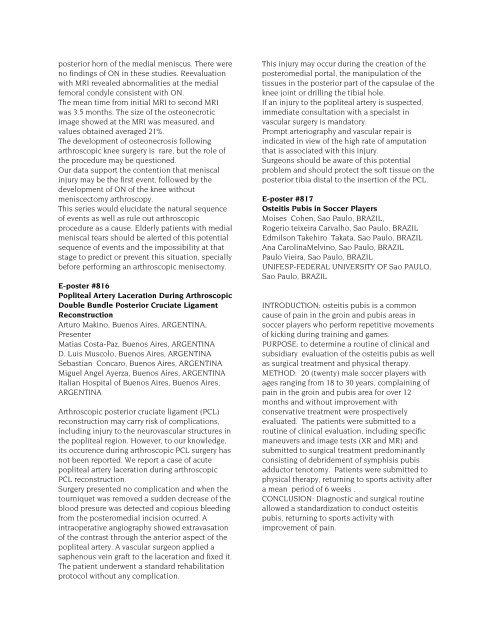POSTER ABSTRACTS - ISAKOS
POSTER ABSTRACTS - ISAKOS
POSTER ABSTRACTS - ISAKOS
Create successful ePaper yourself
Turn your PDF publications into a flip-book with our unique Google optimized e-Paper software.
posterior horn of the medial meniscus. There were<br />
no findings of ON in these studies. Reevaluation<br />
with MRI revealed abnormalities at the medial<br />
femoral condyle consistent with ON.<br />
The mean time from initial MRI to second MRI<br />
was 3.5 months. The size of the osteonecrotic<br />
image showed at the MRI was measured, and<br />
values obtained averaged 21%.<br />
The development of osteonecrosis following<br />
arthroscopic knee surgery is rare, but the role of<br />
the procedure may be questioned.<br />
Our data support the contention that meniscal<br />
injury may be the first event, followed by the<br />
development of ON of the knee without<br />
meniscectomy arthroscopy.<br />
This series would elucidate the natural sequence<br />
of events as well as rule out arthroscopic<br />
procedure as a cause. Elderly patients with medial<br />
meniscal tears should be alerted of this potential<br />
sequence of events and the impossibility at that<br />
stage to predict or prevent this situation, specially<br />
before performing an arthroscopic menisectomy.<br />
E-poster #816<br />
Popliteal Artery Laceration During Arthroscopic<br />
Double Bundle Posterior Cruciate Ligament<br />
Reconstruction<br />
Arturo Makino, Buenos Aires, ARGENTINA,<br />
Presenter<br />
Matias Costa-Paz, Buenos Aires, ARGENTINA<br />
D. Luis Muscolo, Buenos Aires, ARGENTINA<br />
Sebastian Concaro, Buenos Aires, ARGENTINA<br />
Miguel Angel Ayerza, Buenos Aires, ARGENTINA<br />
Italian Hospital of Buenos Aires, Buenos Aires,<br />
ARGENTINA<br />
Arthroscopic posterior cruciate ligament (PCL)<br />
reconstruction may carry risk of complications,<br />
including injury to the neurovascular structures in<br />
the popliteal region. However, to our knowledge,<br />
its occurence during arthroscopic PCL surgery has<br />
not been reported. We report a case of acute<br />
popliteal artery laceration during arthroscopic<br />
PCL reconstruction.<br />
Surgery presented no complication and when the<br />
tourniquet was removed a sudden decrease of the<br />
blood presure was detected and copious bleeding<br />
from the posteromedial incision ocurred. A<br />
intraoperative angiography showed extravasation<br />
of the contrast through the anterior aspect of the<br />
popliteal artery. A vascular surgeon applied a<br />
saphenous vein graft to the laceration and fixed it.<br />
The patient underwent a standard rehabilitation<br />
protocol without any complication.<br />
This injury may occur during the creation of the<br />
posteromedial portal, the manipulation of the<br />
tissues in the posterior part of the capsulae of the<br />
knee joint or drilling the tibial hole.<br />
If an injury to the popliteal artery is suspected,<br />
immediate consultation with a specialst in<br />
vascular surgery is mandatory.<br />
Prompt arteriography and vascular repair is<br />
indicated in view of the high rate of amputation<br />
that is associated with this injury.<br />
Surgeons should be aware of this potential<br />
problem and should protect the soft tissue on the<br />
posterior tibia distal to the insertion of the PCL.<br />
E-poster #817<br />
Osteitis Pubis in Soccer Players<br />
Moises Cohen, Sao Paulo, BRAZIL,<br />
Rogerio teixeira Carvalho, Sao Paulo, BRAZIL<br />
Edmilson Takehiro Takata, Sao Paulo, BRAZIL<br />
Ana CarolinaMelvino, Sao Paulo, BRAZIL<br />
Paulo Vieira, Sao Paulo, BRAZIL<br />
UNIFESP-FEDERAL UNIVERSITY OF Sao PAULO,<br />
Sao Paulo, BRAZIL<br />
INTRODUCTION: osteitis pubis is a common<br />
cause of pain in the groin and pubis areas in<br />
soccer players who perform repetitive movements<br />
of kicking during training and games.<br />
PURPOSE: to determine a routine of clinical and<br />
subsidiary evaluation of the osteitis pubis as well<br />
as surgical treatment and physical therapy.<br />
METHOD: 20 (twenty) male soccer players with<br />
ages ranging from 18 to 30 years, complaining of<br />
pain in the groin and pubis area for over 12<br />
months and without improvement with<br />
conservative treatment were prospectively<br />
evaluated. The patients were submitted to a<br />
routine of clinical evaluation, including specific<br />
maneuvers and image tests (XR and MR) and<br />
submitted to surgical treatment predominantly<br />
consisting of debridement of symphisis pubis<br />
adductor tenotomy. Patients were submitted to<br />
physical therapy, returning to sports activity after<br />
a mean period of 6 weeks .<br />
CONCLUSION: Diagnostic and surgical routine<br />
allowed a standardization to conduct osteitis<br />
pubis, returning to sports activity with<br />
improvement of pain.
















